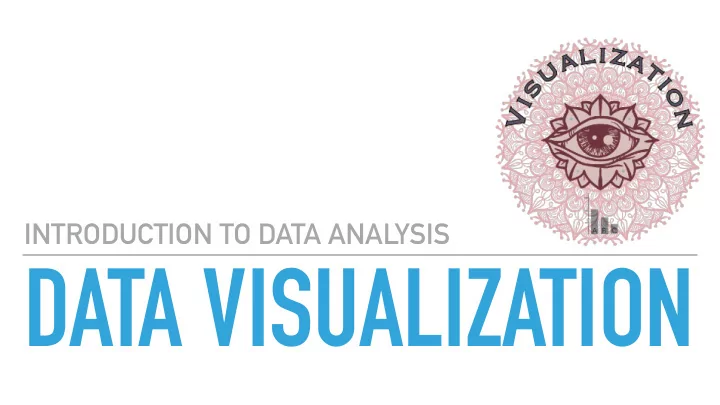

INTRODUCTION TO DATA ANALYSIS DATA VISUALIZATION
INTRODUCTION TO DATA ANALYSIS LEARNING GOALS ▸ obtain a basic understanding of better/worse plotting ▸ understand the idea of hypothesis-driven visualization ▸ develop a basic understanding of the 'grammar of graphs' ▸ get familiar with frequent visualization strategies ▸ barplots, densities, violins, error bars etc. ▸ be able to fine-tune graphs for better visualization
Motivation
INTRODUCTION TO DATA ANALYSIS WHY VISUALIZE? ▸ a picture can be worth a million words (and numbers) ▸ every data analysis should start with a ‘getting to know the data’ phase ▸ visualization of different aspects of data is key to get intimate with the data ▸ data visualization as a means of communication (with others) ▸ hypothesis-driven visualization: obtain visual (suggestive) evidence regarding a research question of relevance
INTRODUCTION TO DATA ANALYSIS WHY VISUALIZE? ▸ a picture can be worth a million words (and numbers) ▸ summary statistics can be misleading (because of information loss) ▸ every data analysis should start with a ‘getting to know the data’ phase ▸ use extensive visualization to get intimate with the data ▸ data visualization as a means of communication (with others / with yourself) ▸ hypothesis-driven visualization: obtain visual (suggestive) evidence regarding a research question of relevance
INTRODUCTION TO DATA ANALYSIS BEYOND SUMMARY STATISTICS
INTRODUCTION TO DATA ANALYSIS MOTIVATING EXAMPLE :: ANSCOMBE’S QUARTET ▸ famous data set, ships with core R messy start tidy up nice!
INTRODUCTION TO DATA ANALYSIS MOTIVATING EXAMPLE :: ANSCOMBE’S QUARTET input data summarise all four groups look very similar!
INTRODUCTION TO DATA ANALYSIS MOTIVATING EXAMPLE :: ANSCOMBE’S QUARTET ▸ quite different patterns despite similar correlation
The good, the bad and the info-graphic
INTRODUCTION TO DATA ANALYSIS PRINCIPLES OF GOOD VISUALIZATION ▸ maximize data-ink ratio (Tufte 1983) ▸ maximize information, minimize ink ▸ contra chart junk ▸ ink vs. processing effort ▸ analogy to language ▸ information flow ▸ ease of processing ▸ bound by conventional rules ▸ hypothesis-driven visualization ▸ relevance of information
INTRODUCTION TO DATA ANALYSIS EXAMPLE OF UNINFORMATIVE PLOTTING
INTRODUCTION TO DATA ANALYSIS EXAMPLE OF INFORMATIVE HYPOTHESIS-DRIVEN PLOTTING
INTRODUCTION TO DATA ANALYSIS EXAMPLE OF UNINFORMATIVE PLOTTING
INTRODUCTION TO DATA ANALYSIS EXAMPLE OF (STILL) UNINFORMATIVE PLOTTING
INTRODUCTION TO DATA ANALYSIS EXAMPLE OF INFORMATIVE HYPOTHESIS-DRIVEN PLOTTING
INTRODUCTION TO DATA ANALYSIS INFOGRAPHICS ▸ ≠ hypothesis-driven visualization ▸ purposes: ▸ memorability ▸ eye-catchiness ▸ persuasion ▸ ….
Basics of ggplot
INTRODUCTION TO DATA ANALYSIS BASICS OF GGPLOT ▸ “ grammar of layered graphs ” ▸ incremental composition ▸ layers ▸ system of rich convenience functions & defaults ▸ grouping ▸ multiple ways of customization
INTRODUCTION TO DATA ANALYSIS INCREMENTAL COMPOSITION create a plot display the plot output 😊
INTRODUCTION TO DATA ANALYSIS INCREMENTAL COMPOSITION output
INTRODUCTION TO DATA ANALYSIS INCREMENTAL COMPOSITION ▸ piping data into 1 st argument slot ▸ declaring mapping globally for all subsequent calls to `geom_` functions output
INTRODUCTION TO DATA ANALYSIS FULL EXAMPLE
INTRODUCTION TO DATA ANALYSIS FULL EXAMPLE title subtitle legend for group distinction y-axis label grid lines data points y-axis tick labels linear regression lines
INTRODUCTION TO DATA ANALYSIS FULL EXAMPLE :: CODE
INTRODUCTION TO DATA ANALYSIS LAYERED GRAMMAR OF GRAPHS output equivalent ▸ `geom_` functions are wrappers ▸ default stat. transform, position, axis type etc. ▸ defaults can be overwritten
Layers
INTRODUCTION TO DATA ANALYSIS LAYERS
INTRODUCTION TO DATA ANALYSIS LAYER ORDER
INTRODUCTION TO DATA ANALYSIS OPACITY
INTRODUCTION TO DATA ANALYSIS DIFFERENT DATA FOR DIFFERENT LAYERS
Grouping
INTRODUCTION TO DATA ANALYSIS GROUPING ▸ group information for uniform display in terms of color, shape, etc.
INTRODUCTION TO DATA ANALYSIS GLOBAL GROUPING ▸ global grouping applies to all subsequent layers
INTRODUCTION TO DATA ANALYSIS OVERWRITING GROUPING INFORMATION ▸ overwriting grouping information locally
INTRODUCTION TO DATA ANALYSIS DIFFERENT GROUPING IN DIFFERENT LAYERS ▸ each layer has its own grouping information
Geoms & plot types
INTRODUCTION TO DATA ANALYSIS SCATTER PLOTS
INTRODUCTION TO DATA ANALYSIS CURVE AND LINE FITS
INTRODUCTION TO DATA ANALYSIS LINE PLOTS
INTRODUCTION TO DATA ANALYSIS BAR PLOTS
INTRODUCTION TO DATA ANALYSIS BAR PLOTS
INTRODUCTION TO DATA ANALYSIS BAR PLOTS CAN BE UNDERINFORMATIVE ▸ suboptimal data-ink ratio ▸ lacks distributional information
INTRODUCTION TO DATA ANALYSIS BAR PLOTS CAN OKAY ▸ choice proportions ▸ with 95% bootstrapped CIs
INTRODUCTION TO DATA ANALYSIS HISTOGRAMS ▸ fix bins ▸ count number of data points in each bin ▸ plot as bar
INTRODUCTION TO DATA ANALYSIS BOX PLOTS ▸ visualize common summary statistics ▸ mean ▸ 25% & 75% quantile ▸ …
INTRODUCTION TO DATA ANALYSIS DENSITY PLOTS ▸ “generalized histogram” ▸ uses kernel estimation to predict smoothed curves
INTRODUCTION TO DATA ANALYSIS VIOLIN PLOTS ▸ “mirrored density plots” ▸ good for multi-group comparisons
INTRODUCTION TO DATA ANALYSIS RUG PLOTS ▸ show data points near axis
INTRODUCTION TO DATA ANALYSIS RUG PLOTS ▸ show data points near axis
INTRODUCTION TO DATA ANALYSIS ANNOTATION
INTRODUCTION TO DATA ANALYSIS ANNOTATION
Faceting
INTRODUCTION TO DATA ANALYSIS FACET GRID
INTRODUCTION TO DATA ANALYSIS FACET WRAP
Bells & whistles
INTRODUCTION TO DATA ANALYSIS READY-MADE THEMES
INTRODUCTION TO DATA ANALYSIS TWEAKING AN EXISTING THEME
Recommend
More recommend